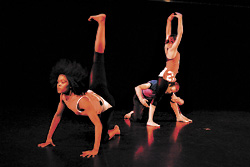At the end of Spectrum Dance Theater’s “The Male Voice” last weekend, one of the audience members asked the question begged by the program: How exactly were the works “associated with testosterone”? What was “male” about these “voices”? Spectrum director Donald Byrd turned the question back on the questioner (“What do you think is ‘male’ about them?”), and in the end the query went unanswered.Are dances by men necessarily more athletic, more aggressive, more formally complex?Or do these works represent a male voice simply because they are made by men?For Byrd, the last idea is the valid one, and the onus is on the audience to discover what that maleness might be.For the four other choreographers he shares the stage with here, that male element is all over the map.
Daniel Wilkins has danced for Byrd in the past—with Spectrum and an earlier, New York–based company—and some of Byrd’s aggressive energy seems to have rubbed off on him, along with an interest in high-test virtuosity. Both of these qualities appear in Mirage, a suite of interconnected pieces with an underlying harshness, as if the four dancers were in perpetual competition. The performers are sleek, lithe, and a little sullen as they twist and dodge. Mirage is at its best when working in counterpoint to the hip-hop score, as in the duet for Sharron Williams and Peter de Grasse with a series of extended, counterbalanced shapes. Wilkins describes his style as “all-terrain dance,” and it does have a rough-and-ready sense to it; what he might think about next is a contrasting lyricism.
Cyrus Khambatta’s He Chases Shadows does deal with some aspects of maleness, as a pair of female commentators pass along observations about the three men in the cast: “He’s afraid he’s not enough like his father,” “He tends to be shy,” “He has a fear of the telephone.” The women, who eventually join the dancing, begin to sound like mothers, explaining the vagaries of their children to someone else waiting at the bus stop. Khambatta’s background in contact improvisation is clearly at play in the movement’s tumbling quality and the surging weight shifts of his partnering. As the three men, de Grasse, Joel Myers, and Jonathan Pignataro all have an offhanded excellence, loping across the stage.
Kiyon Gaines and Olivier Wevers both have “day jobs” as dancers with Pacific Northwest Ballet, and Gaines has made a handful of bright works for that company. In the past he’s seemed to be exploring traffic patterns onstage—moving groups around—but this new work, In(Vision), has more feeling for the individual. A long sequence has Myers almost sitting in a chair over and over again—each time distracted away from rest, then returning for another try.
Wevers’ 2006 crowded murmurs…thoughts for Spectrum was a chamber-sized dance that made charming use of its Mozart score. Fragments does the same, playing on our familiarity with some well-known arias from The Marriage of Figaro and The Magic Flute. The dancers lip-synch in grand operatic style, scratch their itches like puppies, and adjust their costumes. Here, ballet technique is about freedom, not power, and it seems that Kelly Ann Barton and Hannah Lagerway are set to burble their way around the stage for the duration of the work, until the score shifts to Mozart’s Ave Verum. Lagerway strips off her flirty skirt and proceeds to turn herself inside out and upside down in an extended adagio that’s all bent joints, like a colt learning to stand. Probably the most effective part of the work has the least amount of movement, as Lagerway pauses for several breaths, upside down and all splayed out.
By his own estimation, Byrd has choreographed close to 100 pieces, and his experience really shines here. A duet from the 1992 Drastic Cuts shows him at his edgy best, as the dancers pace around the stage whipping off multiple turns and tricky footwork. He seems to take delight in quoting from the historical repertory—with moments from George Balanchine’s Serenade salted through Cuts and references to Martha Graham’s austere emotionalism in his 2007 Solo. Avian Pas is a revision of the white swan pas de deux in Swan Lake. Unlike his 2005 Sleeping Beauty Notebook, which was a serious revisioning of the ballet, this is primarily played for laughs rather than tragedy—more Carol Burnett than Matthew Bourne.








